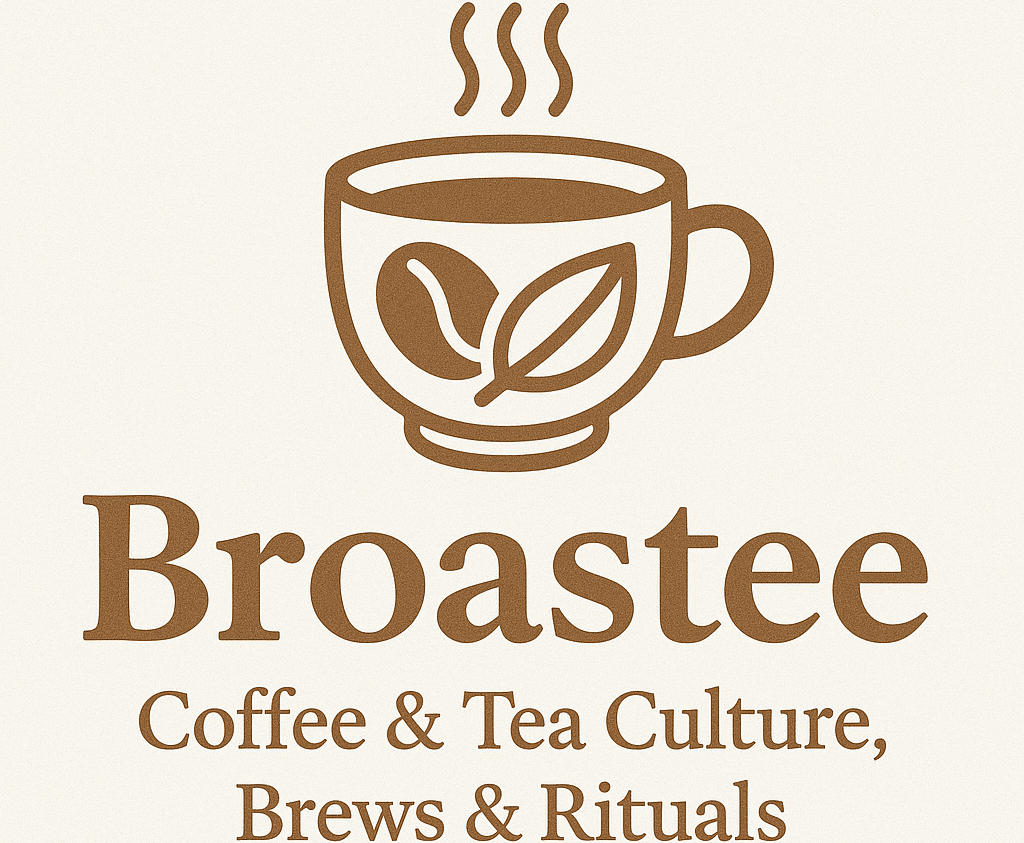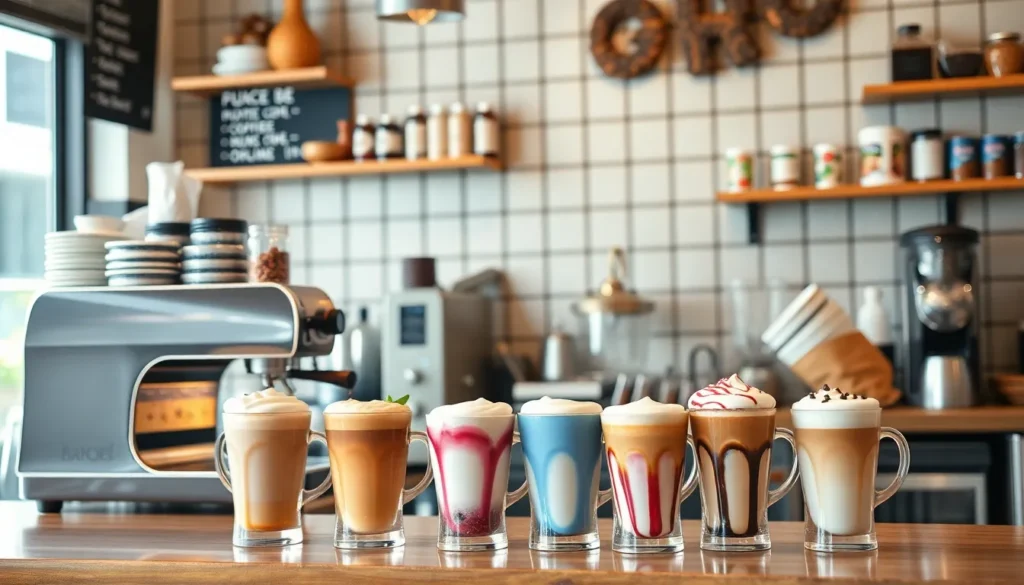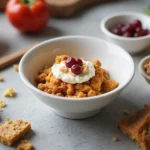We’ve all been there – standing in line at our favorite coffee shop, staring at the menu board filled with Italian names that make our heads spin. Cappuccino, macchiato, cortado – they all sound sophisticated, but what’s the real difference between these beloved espresso drinks?
The industry of espresso-based beverages isn’t as complicated as it seems. Each drink follows a simple formula: espresso shots combined with varying amounts of steamed milk, foam, or water. Understanding these ratios unlocks the secret to ordering exactly what you’re craving, whether it’s a bold morning wake-up call or a smooth afternoon treat.
We’re here to demystify the art of espresso drinks and help you navigate that intimidating coffee menu with confidence. From the basics of espresso itself to the subtle differences between a flat white and a latte, you’ll discover how each drink’s unique character can transform your daily coffee ritual into something truly special.
What Are Espresso Drinks and Why They Matter
Espresso drinks form the foundation of modern coffee culture, representing a precise art that transforms simple ingredients into complex flavor experiences. We’ve discovered that understanding these beverages isn’t just about ordering coffee—it’s about appreciating how Italian brewing traditions shaped our daily rituals.
Espresso serves as the base for virtually every coffee shop beverage you’ll encounter. This concentrated coffee extract, brewed under 9 bars of pressure in 25-30 seconds, delivers intense flavor and caffeine in a small package. Traditional espresso shots contain approximately 63mg of caffeine per fluid ounce, making them significantly stronger than regular drip coffee.
Milk integration techniques distinguish one espresso drink from another through precise ratios and textures. Steamed milk, microfoam, and cold milk each create different mouthfeels and flavor profiles when combined with espresso. Professional baristas control temperature, texture, and pouring speed to achieve the exact balance each drink requires.
Cultural significance extends beyond mere caffeine consumption, as these drinks represent social experiences and personal preferences. Italians traditionally consume cappuccinos only in the morning, while Americans embrace these beverages throughout the day. Coffee shops have become community gathering spaces where espresso drinks help conversations and connections.
Economic impact shows espresso-based beverages generate over 60% of specialty coffee shop revenue nationwide. Popular drinks like lattes and cappuccinos command premium prices because they require skilled preparation and quality ingredients. Understanding these drinks helps consumers make informed choices about their coffee investments.
Flavor complexity emerges from the interaction between espresso’s concentrated oils and milk proteins during the steaming process. Each drink offers a unique balance of sweetness, bitterness, and richness that appeals to different taste preferences. Mastering these combinations allows coffee enthusiasts to explore diverse flavor profiles within familiar frameworks.
Essential Espresso-Based Coffee Beverages Every Coffee Lover Should Know
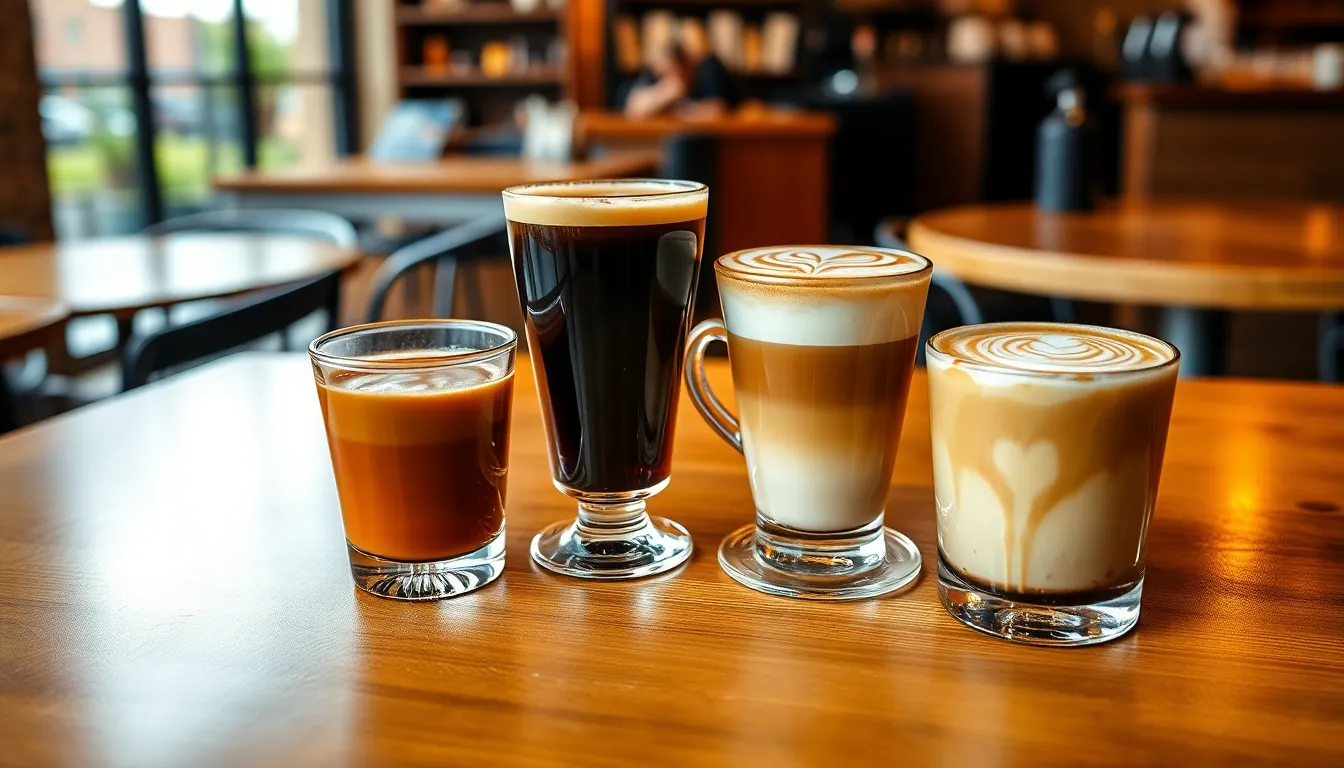
Understanding these core espresso drinks forms the foundation for handling any coffee menu with confidence. Each beverage showcases unique characteristics that cater to different flavor preferences and caffeine needs.
Espresso Shot
Espresso shots deliver concentrated coffee excellence in its purest form. We create this beverage by forcing pressurized hot water through finely ground coffee beans, creating a dense and rich foundation for countless coffee creations. A typical serving measures 1-2 ounces, packing intense flavor into every sip.
Strong coffee enthusiasts gravitate toward espresso’s bold characteristics and uncompromising intensity. Coffee connoisseurs appreciate how this brewing method extracts maximum flavor compounds while preserving essential oils that create the signature crema layer. Premium espresso shots showcase the bean’s origin characteristics without dilution or milk interference.
Americano
Americano transforms espresso’s intensity into a smoother coffee experience through strategic dilution. We create this beverage by adding hot water to a fresh espresso shot, producing a milder flavor profile that appeals to traditional coffee drinkers. Hot water integration reduces the concentrated espresso’s boldness while maintaining its essential coffee character.
Coffee shops worldwide serve Americanos as an alternative for customers who prefer less intense flavors than pure espresso. Baristas typically use a 1:2 ratio of espresso to hot water, though personal preferences can adjust this proportion. Water temperature plays a crucial role in preserving the espresso’s flavor integrity during the dilution process.
Cappuccino
Cappuccino represents the artful balance of espresso, steamed milk, and frothed milk in perfect harmony. We layer these three components to create distinct taste zones that coffee lovers can experience with each sip. Skilled baristas maintain clear separation between the dense espresso base, creamy steamed milk middle, and airy frothed milk crown.
Stronger taste profiles distinguish cappuccinos from other milk-based espresso drinks due to their balanced ratios. Traditional Italian preparation calls for equal parts espresso, steamed milk, and frothed milk, creating a 6-ounce beverage. Coffee shops often serve cappuccinos in smaller cups to preserve the intended flavor concentration and temperature.
Latte
Latte composition emphasizes smooth milk integration with espresso for a sweeter coffee experience. We blend espresso with generous amounts of steamed milk, topped with just a thin layer of frothed milk. Higher milk content creates the latte’s signature creamy texture and naturally sweet flavor profile.
Milky characteristics make lattes more approachable for coffee newcomers and those who prefer gentler caffeine delivery. Coffee shops typically serve lattes in larger cups ranging from 8-16 ounces, accommodating the increased milk volume. Baristas can create latte art by pouring steamed milk in exact patterns, making these drinks visually appealing alongside their smooth taste.
Popular Espresso Drinks for Different Taste Preferences
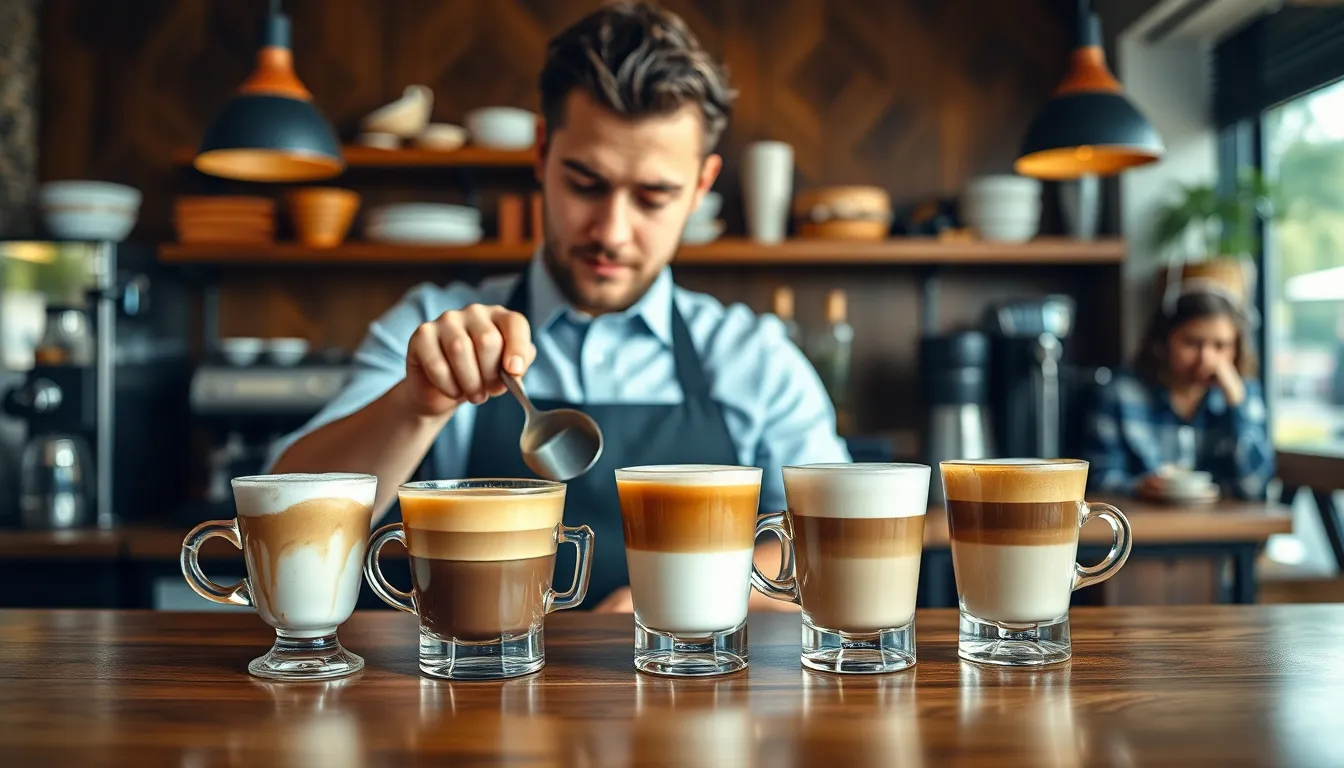
We’ve explored the fundamental espresso beverages, but let’s jump into exact drinks that cater to distinct flavor preferences and intensity levels.
Macchiato
Macchiato delivers intense espresso flavor with just a hint of milk to soften the edges. We make this drink by “marking” a shot of espresso with a small dollop of steamed milk or foam, creating a perfect balance for those who want strong coffee without overwhelming dairy. The traditional macchiato contains approximately 90% espresso and only 10% milk, making it ideal for coffee purists who appreciate bold flavors. Baristas typically serve this drink in a small demitasse cup, allowing the espresso’s natural oils and crema to shine through while the minimal milk addition provides just enough smoothness to enhance rather than mask the coffee’s complexity.
Mocha
Mocha transforms your espresso experience into a decadent chocolate coffee treat that satisfies both caffeine and dessert cravings. We create this indulgent drink by combining espresso shots with steamed milk and rich chocolate syrup or cocoa powder, often finishing it with a generous dollop of whipped cream. The typical mocha contains equal parts espresso and chocolate, creating a harmonious blend where neither flavor dominates the other. Coffee shops often customize mochas with different chocolate varieties, from dark chocolate for sophisticated palates to white chocolate for those preferring sweeter profiles, making this drink exceptionally versatile for various taste preferences.
Flat White
Flat White offers the perfect middle ground between a cappuccino and a latte with its signature velvety microfoam texture. We prepare this drink using double espresso shots topped with steamed milk that’s been expertly textured to create smooth, glossy microfoam rather than the airy foam found in cappuccinos. The milk to espresso ratio typically ranges from 4:1 to 6:1, allowing the coffee’s bold flavor to remain prominent while providing creamy smoothness. Originally from Australia and New Zealand, the flat white has gained worldwide popularity among coffee enthusiasts who appreciate strong espresso flavor without excessive sweetness or foam interference.
Cortado
Cortado achieves perfect harmony between espresso and milk with its distinctive equal parts ratio and foam free preparation. We serve this Spanish originated drink in a small glass, typically containing one to two espresso shots mixed with an equal amount of warm steamed milk. The absence of foam creates an exceptionally smooth drinking experience that allows both the espresso’s intensity and the milk’s sweetness to complement each other seamlessly. The cortado’s 1:1 ratio makes it stronger than a latte but milder than a macchiato, positioning it as an ideal choice for those who want balanced coffee and milk flavors without any textural distractions from foam.
Creative Espresso Drinks That Push Traditional Boundaries
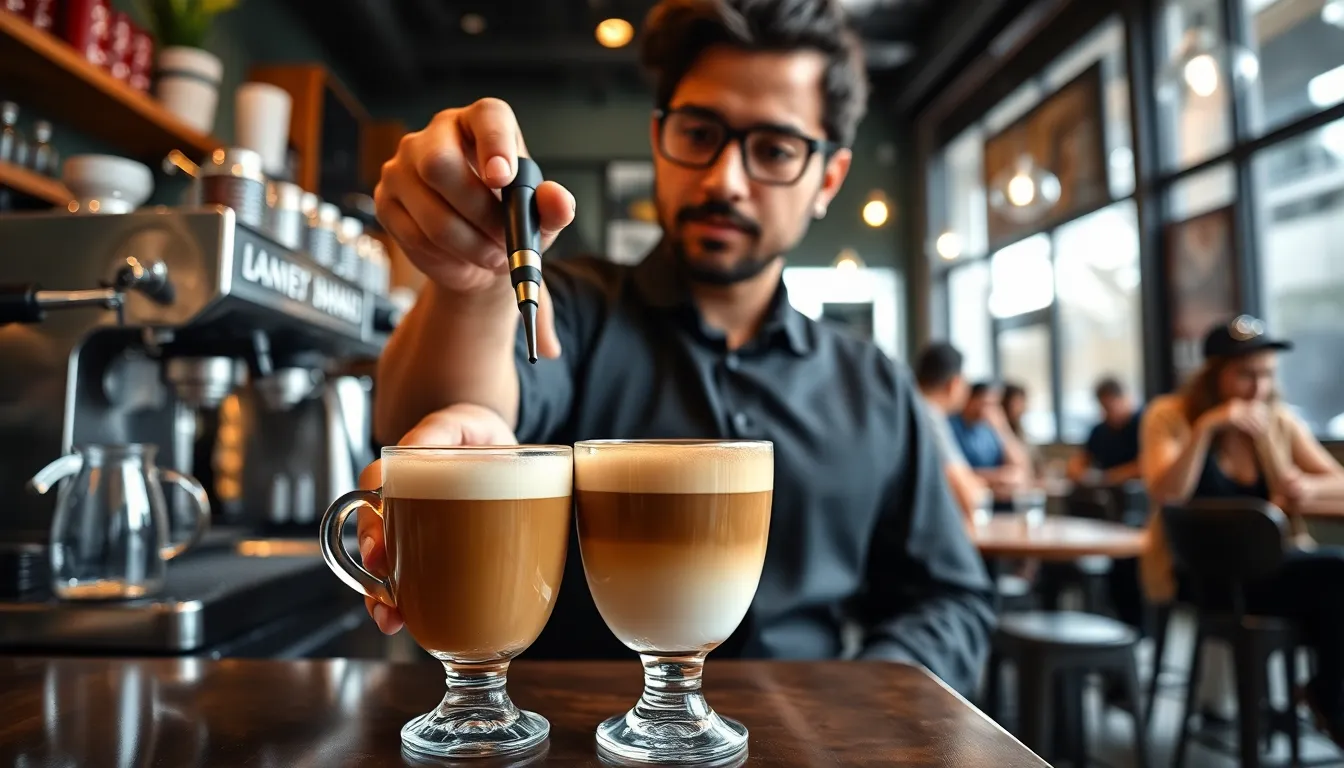
We’re venturing beyond classic espresso territory to explore innovative drinks that challenge conventional coffee expectations. These creative variations showcase how baristas and coffee enthusiasts continue pushing boundaries while honoring espresso’s foundational elements.
Gibraltar
Gibraltar stands as San Francisco’s distinctive contribution to espresso culture, offering a unique twist on the traditional cortado concept. We find this drink served in its signature glass cup, featuring a shot of espresso “marked” with a thin layer of steamed milk. The espresso to milk ratio runs higher than conventional cortados, placing intense espresso flavor at the forefront of each sip. This drink perfectly bridges the gap between a pure espresso shot and milk based beverages, delivering concentrated coffee excellence with just enough milk to soften the edges.
Red Eye
Red Eye delivers an intense caffeine experience that combines the best of both brewing worlds. We start with a freshly brewed cup of drip coffee, then add a double shot of espresso for maximum impact. This combination creates a powerhouse drink that appeals to those seeking serious caffeine content and complex flavor profiles. The marriage of drip coffee’s smooth body with espresso’s concentrated intensity produces a unique drinking experience that pushes traditional coffee boundaries.
Affogato
Affogato transforms espresso into a dessert experience, literally “drowning” vanilla ice cream in hot espresso shots. We pour the freshly brewed espresso directly over a scoop of premium vanilla ice cream, creating an instant contrast of temperatures and textures. The hot espresso melts the ice cream gradually, producing a creamy coffee sauce that combines bitter and sweet elements perfectly. This Italian inspired creation demonstrates how espresso’s versatility extends beyond traditional beverage categories into dessert territory.
Espresso Romano
Espresso Romano adds Mediterranean flair to traditional espresso service through the simple addition of fresh lemon. We serve this variation with a slice of lemon on the side, allowing the citrus acidity to enhance and brighten the espresso’s natural flavor profile. The lemon’s acidity creates an interesting counterpoint to espresso’s inherent bitterness, producing a more complex taste experience. This preparation method shows how minimal additions can dramatically transform familiar drinks while maintaining espresso’s essential character.
Regional Espresso Drinks From Around the World
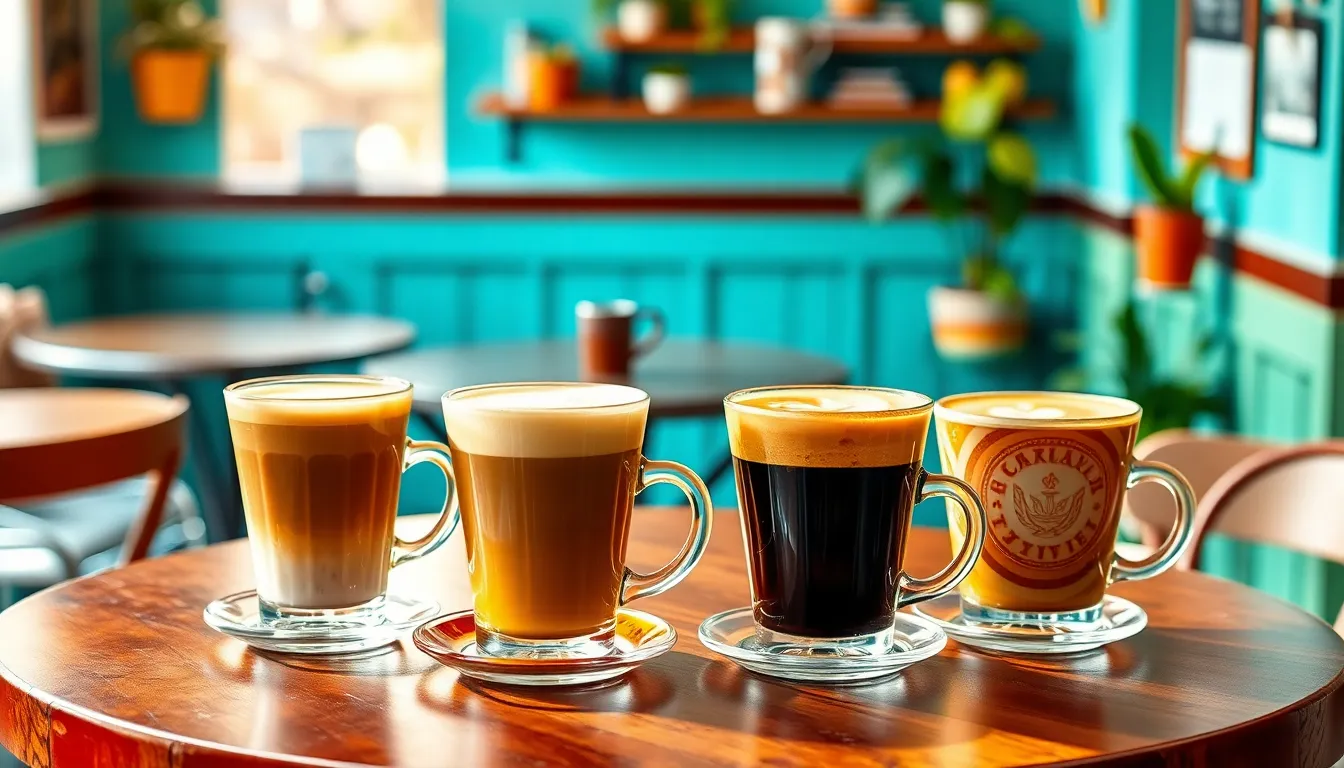
Coffee cultures across different countries have developed unique espresso variations that reflect local tastes and traditions. We’ll explore these distinctive regional drinks that showcase how espresso adapts to different cultural preferences.
Café Bombón (Spain)
Café Bombón brings sweetness and visual appeal to Valencia’s coffee scene through its distinctive layered presentation. Equal parts espresso and sweetened condensed milk create this Spanish specialty that delivers both richness and aesthetic charm. Preparation involves brewing a shot of espresso first, then carefully adding an equal amount of sweetened condensed milk to create beautiful layers in a small glass. Spanish coffee lovers appreciate this drink’s balance between intense espresso flavor and creamy sweetness. The condensed milk adds a luxurious texture that transforms the traditional espresso experience into something uniquely Mediterranean.
Café Noisette (France)
Café Noisette represents France’s refined approach to milk and espresso combinations, differing from the country’s traditional café au lait. French baristas add just a small amount of steamed milk to espresso, creating a drink that’s stronger than café au lait but gentler than pure espresso. Unlike café au lait which uses scalded milk, Noisette incorporates steamed milk for a smoother texture. This beverage appeals to coffee drinkers who want espresso’s intensity softened by milk’s creamy influence. French coffee culture values this drink’s subtle balance that doesn’t overwhelm the espresso’s natural flavors.
Café Cubano (Cuba)
Café Cubano transforms espresso through Cuba’s unique sugar integration technique that creates exceptional sweetness and strength. Cuban coffee culture adds sugar directly to the espresso grounds before brewing, resulting in a naturally sweet and rich flavor profile. Some variations include milk for additional richness, though the traditional version focuses on the sugar and espresso combination. This brewing method ensures the sugar fully integrates with the coffee during extraction rather than being added afterward. Cuban coffee enthusiasts prize this drink for its intense sweetness and bold espresso character that reflects the island’s vibrant coffee traditions.
Long Black (Australia)
Long Black showcases Australia’s distinctive approach to diluted espresso that differs significantly from the American Americano. Australian coffee culture creates this drink by adding espresso to hot water rather than pouring water over espresso, preserving more of the coffee’s crema and flavor intensity. This preparation method results in a stronger coffee taste compared to traditional Americanos. The technique maintains the espresso’s aromatic oils and creates a more robust drinking experience. Australian baristas developed this method to satisfy customers who wanted stronger coffee than drip brew but less intense than straight espresso.
How to Choose the Right Espresso Drinks for Your Palate
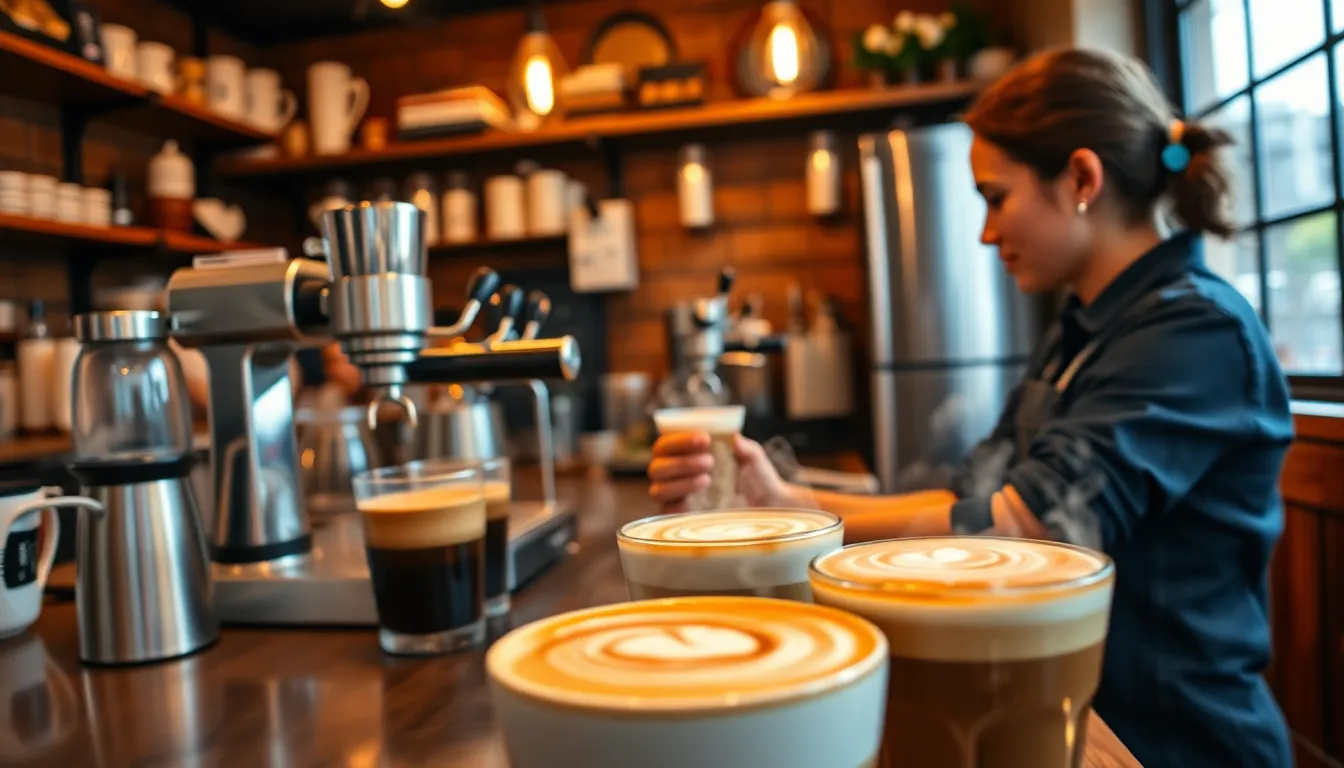
Selecting the perfect espresso drink becomes much easier when we understand the fundamental elements that shape each beverage’s character. We’ll explore three key factors that help match your personal preferences with the ideal coffee experience.
Understanding Milk-to-Coffee Ratios
Milk-to-coffee ratios determine the texture and strength of your drink. We find that a standard espresso shot contains 1 ounce with no milk, delivering pure coffee intensity. Cappuccinos feature equal parts espresso, steamed milk, and foam, creating a balanced harmony between coffee strength and creamy texture. Lattes contain mostly milk with a single espresso shot, resulting in a creamier and milder flavor profile that appeals to those seeking smoothness over intensity.
Smaller drinks offer stronger coffee experiences. We recommend the piccolo latte for coffee lovers who want a short shot with just a splash of milk, maintaining bold espresso character. Flat whites balance velvety microfoam with concentrated espresso shots, creating a coffee-forward drink without overwhelming milk presence. Latte macchiatos feature mainly steamed milk with just a hint of espresso, perfect for those who prefer subtle coffee notes.
Identifying Flavor Profiles
Flavor profiles vary dramatically based on ingredients and preparation methods. We observe that straight espresso delivers bold and intense flavors, while ristretto shots made with less water provide even more concentrated taste experiences. Adding chocolate transforms drinks like mochas into dessert-like beverages that satisfy both coffee cravings and sweet tooth desires.
Milk integration softens bitterness while adding natural sweetness. We notice that steamed milk in lattes and cappuccinos mellows espresso’s sharp edges, creating approachable drinks for coffee newcomers. Noisette drinks feature just a touch of foamed milk, maintaining strength while providing smooth texture. Different milk temperatures and textures contribute unique mouthfeel experiences that complement espresso’s complex flavor compounds.
Considering Caffeine Content
Caffeine levels depend primarily on espresso shot quantities rather than milk additions. We know that a single espresso shot typically contains 60-80 mg of caffeine, providing a reliable baseline for measuring drink strength. Doppio shots deliver twice the caffeine content and double the coffee intensity, perfect for those needing stronger energy boosts.
Milk-based drinks maintain consistent caffeine per shot even though different flavor experiences. We find that cappuccinos and lattes contain identical caffeine amounts per espresso shot, though higher milk content creates a milder perceived effect. Americanos provide similar caffeine content to straight espresso while offering a gentler flavor through hot water dilution, making them ideal for those wanting extended sipping experiences without overwhelming intensity.
Tips for Ordering Espresso Drinks Like a Pro
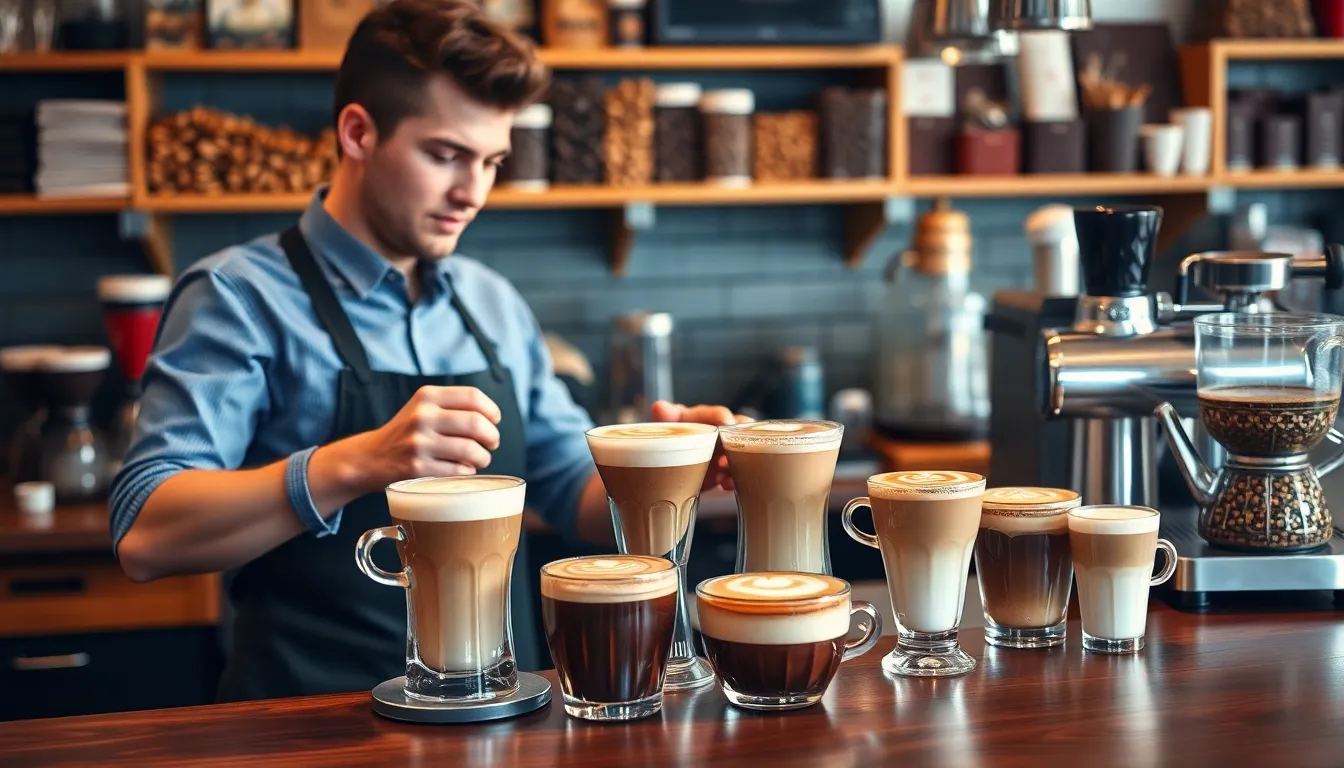
Mastering the art of ordering espresso drinks transforms your coffee shop experience from confusion to confidence. We’ll guide you through the essential knowledge that separates coffee novices from seasoned enthusiasts.
Knowing the Terminology
Understanding coffee terminology helps you communicate your preferences clearly to any barista. Espresso forms the foundation of most coffee shop beverages, created by forcing hot water through finely ground coffee beans under pressure. This concentrated shot delivers intense flavor and serves as the base for countless drink variations.
Ristretto takes concentration to the next level, using finer grounds and less water to produce an even more intense espresso experience. Many coffee purists prefer this option when they want maximum flavor without dilution. Doppio simply means a double shot of espresso, using twice the amount of coffee grounds as a regular shot for those who need extra caffeine or stronger flavor.
Cappuccino combines espresso with equal parts steamed milk and foam, creating the classic Italian coffee experience. The foam layer provides insulation and adds texture to each sip. Latte features espresso and steamed milk with just a thin layer of foam, offering a smoother and sweeter taste profile than cappuccinos.
Macchiato literally means “marked” in Italian, referring to espresso marked with a small amount of milk. Traditional macchiatos contain very little milk, maintaining the espresso’s bold character while adding just a hint of sweetness.
Understanding Size Options
Size selection affects both your caffeine intake and flavor intensity in espresso-based drinks. Single shots represent the standard espresso serving, typically measuring 1 ounce and containing approximately 63 milligrams of caffeine. Most coffee shops use single shots as their default unless you specify otherwise.
Double shots (Doppio) contain about 2 ounces of espresso and roughly 126 milligrams of caffeine. Many experienced coffee drinkers prefer double shots because they provide more balanced flavor in milk-based drinks. The extra espresso prevents the milk from overwhelming the coffee taste.
Piccolo lattes offer a smaller version of traditional lattes, using less milk to maintain a stronger coffee-to-milk ratio. This size works perfectly when you want the latte experience without committing to a full-sized drink. The smaller portion also allows you to enjoy the coffee’s complexity without dilution.
Customization Possibilities
Milk alternatives expand your ordering options beyond traditional dairy choices. Whole milk provides the richest texture and sweetest natural flavor, while skim milk reduces calories without significantly altering taste. Almond milk adds subtle nuttiness, soy milk contributes protein and smooth texture, and oat milk delivers creamy consistency that many baristas prefer for latte art.
Flavorings allow you to personalize your drink without masking the espresso’s character. Vanilla syrup complements most espresso drinks, hazelnut adds warmth and richness, and caramel provides sweetness with complexity. Start with half pumps of syrup to avoid overwhelming the coffee’s natural flavors.
Sweetener options range from traditional sugar to honey and artificial alternatives. Natural sweeteners like honey dissolve better in hot drinks and add subtle flavor notes. Sugar integrates seamlessly, while artificial sweeteners work well for those monitoring calorie intake.
Foam specifications let you control texture and temperature retention. Request “no foam” for maximum liquid volume, “light foam” for subtle texture, or “extra foam” for traditional cappuccino experience. Dry cappuccinos feature mostly foam with minimal steamed milk, while wet cappuccinos emphasize steamed milk over foam.
Conclusion
We’ve journeyed through the rich industry of espresso drinks together and discovered that what seems complex at first is actually quite accessible once you understand the fundamentals. Armed with knowledge about milk ratios flavor profiles and regional variations you’re now ready to explore coffee menus with genuine confidence.
The beauty of espresso culture lies in its endless possibilities for personalization. Whether you prefer the bold intensity of a traditional macchiato or the creamy comfort of a flat white there’s an espresso drink perfectly suited to your taste preferences and caffeine needs.
Next time you step into a coffee shop you’ll know exactly how to communicate your preferences and might even feel inspired to try something completely new. The industry of espresso drinks is yours to explore and enjoy.
Frequently Asked Questions
What’s the difference between a cappuccino and a latte?
A cappuccino has equal parts espresso, steamed milk, and thick foam, creating a stronger coffee flavor with a light, airy texture. A latte contains more steamed milk and less foam, resulting in a creamier, milder taste. The cappuccino is typically served in a smaller cup (6 oz) while lattes are larger (8-12 oz).
How do I choose the right espresso drink for my taste preferences?
Consider three key factors: milk-to-coffee ratio, desired flavor intensity, and caffeine needs. If you prefer strong coffee flavor, choose drinks with less milk like macchiatos or cortados. For milder tastes, opt for lattes or flat whites. Single shots provide moderate caffeine, while double shots offer more intensity.
What makes a flat white different from other espresso drinks?
A flat white features a double shot of espresso with steamed milk and velvety microfoam, creating a smooth texture without the thick foam layer found in cappuccinos. It’s stronger than a latte but smoother than a cappuccino, typically served in a 6 oz cup with a higher coffee-to-milk ratio.
Are there espresso drinks without milk?
Yes, several espresso drinks contain no milk. An Americano combines espresso with hot water for a coffee-like experience. Espresso shots can be enjoyed straight, while Espresso Romano adds a lemon twist. The Red Eye combines espresso with drip coffee for extra caffeine without dairy.
What’s the proper way to order espresso drinks at coffee shops?
Learn basic terminology like “doppio” (double shot) and “ristretto” (concentrated shot). Specify your preferred size, milk type (dairy, oat, almond), and any customizations like extra shots or flavoring. Don’t hesitate to ask baristas about drink characteristics if you’re unsure about your choice.
How do regional espresso drinks differ from standard options?
Regional variations reflect local tastes and traditions. Spanish Café Bombón uses sweetened condensed milk, French Café Noisette adds minimal steamed milk, Cuban Café Cubano incorporates sugar during brewing, and Australian Long Black preserves crema by adding espresso to hot water rather than vice versa.
What determines the caffeine content in espresso drinks?
Caffeine content primarily depends on the number of espresso shots used. A single shot contains about 63mg of caffeine, while double shots provide approximately 126mg. The amount of milk, water, or other additions doesn’t significantly affect caffeine levels—only the espresso quantity matters.
Can I customize my espresso drink with different milk alternatives?
Absolutely! Most coffee shops offer various milk alternatives including oat, almond, soy, coconut, and macadamia milk. Each alternative creates different flavors and textures. Oat milk closely mimics dairy’s creaminess, while almond milk provides a lighter, nuttier taste. Baristas can accommodate most dietary preferences and restrictions.
